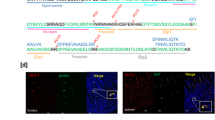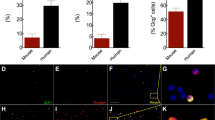Abstract
Glucagon-like peptide-2 (GLP-2) affects multiple facets of gastrointestinal physiology and have been used to treat patients with short bowel syndrome, but the distribution of its receptor (GLP2R) in human remains poorly understood. Gastric tissue samples of non-obese patients (NOB, n=10) and obese patients without diabetes (OB, n=31) and with diabetes (OWD, n=12) were used to evaluate GLP2R expression and distribution. Immunostaining with a validated antibody, as well as fluorescence in situ hybridization, showed that GLP2R expression was significantly increased in gastric chief cells in OB and OWD patients. PKCζ expression was also significantly increased. This is the first evidence of increased GLP2R expression in chief cells of patients with severe obesity regardless of diabetes status.
This is a preview of subscription content, access via your institution
Access options
Subscribe to this journal
Receive 12 print issues and online access
$259.00 per year
only $21.58 per issue
Buy this article
- Purchase on Springer Link
- Instant access to full article PDF
Prices may be subject to local taxes which are calculated during checkout

Similar content being viewed by others
References
Austin K, Markovic MA, Brubaker PL . Current and potential therapeutic targets of glucagon-like peptide-2. Curr Opin Pharmacol 2016; 31: 13–18.
Jeppesen PB . Gut hormones in the treatment of short-bowel syndrome and intestinal failure. Curr Opin Endocrinol Diabetes Obes 2015; 22: 14–20.
Estall JL, Drucker DJ . Glucagon-like peptide-2. Annu Rev Nutr 2006; 26: 391–411.
Wøjdemann M, Wettergren A, Hartmann B, Hilsted L, Holst JJ . Inhibition of sham feeding-stimulated human gastric acid secretion by glucagon-like peptide-2. J Clin Endocrinol Metab 1999; 84: 2513–2517.
Guan X, Karpen HE, Stephens J, Bukowski JT, Niu S, Zhang G et al. GLP-2 receptor localizes to enteric neurons and endocrine cells expressing vasoactive peptides and mediates increased blood flow. Gastroenterology 2006; 130: 150–164.
Guan X, Shi X, Li X, Chang B, Wang Y, Li D et al. GLP-2 receptor in POMC neurons suppresses feeding behavior and gastric motility. Am J Physiol Endocrinol Metab 2012; 303: E853–E864.
Thulesen J, Hartmann B, Hare KJ, Kissow H, Orskov C, Holst JJ et al. Glucagon-like peptide 2 (GLP-2) accelerates the growth of colonic neoplasms in mice. Gut 2004; 53: 1145–1150.
Koehler JA, Harper W, Barnard M, Yusta B, Drucker DJ . Glucagon-like peptide-2 does not modify the growth or survival of murine or human intestinal tumor cells. Cancer Res 2008; 68: 7897–7904.
Trivedi S, Wiber SC, El-Zimaity HM, Brubaker PL . Glucagon-like peptide-2 increases dysplasia in rodent models of colon cancer. Am J Physiol Gastrointest Liver Physiol 2012; 302: G840–G849.
Rotondo A, Amato A, Baldassano S, Lentini L, Mulè F . Gastric relaxation induced by glucagon-like peptide-2 in mice fed a high-fat diet or fasted. Peptides 2011; 32: 1587–1592.
Yusta B, Huang L, Munroe D, Wolff G, Fantaske R, Sharma S et al. Enteroendocrine localization of GLP-2 receptor expression in humans and rodents. Gastroenterology 2000; 119: 744–755.
Nam KT, Lee HJ, Sousa JF, Weis VG, O'Neal RL, Finke PE et al. Mature chief cells are cryptic progenitors for metaplasia in the stomach. Gastroenterology 2010; 139: e9.
Raffaniello RD, Raufman JP . Protein kinase C expression and translocation in dispersed chief cells from guinea-pig stomach. Biochim Biophys Acta 1994; 1224: 551–558.
Sundbom M, Mårdh E, Mårdh S, Ohrvall M, Gustavsson S . Reduction in serum pepsinogen I after Roux-en-Y gastric bypass. J Gastrointest Surg 2003; 7: 529–535.
Acknowledgements
This research is supported by grants from Shanghai Natural Science Foundation (14ZR1436600).
Author contributions
Feng Li conceived and designed the experiments, contributed to immunostaining and in situ hybridization experiments and wrote the manuscript; Ying Peng and Yi Zhang contributed to Western blotting experiments; Jingyang Gao contributed to acquisition of clinical data of patients; Liesheng Lu and Donglei Zhou contributed to gastric tissue samples collection; Dajin Zhou and Hui Sheng contributed to discussion; Shen Qu designed the experiments, contributed to discussion, and reviewed and edited the manuscript.
Author information
Authors and Affiliations
Corresponding authors
Ethics declarations
Competing interests
The authors declare no conflict of interest.
Additional information
Supplementary Information accompanies this paper on International Journal of Obesity website
Supplementary information
Rights and permissions
About this article
Cite this article
Li, F., Lu, L., Peng, Y. et al. Increased GLP2R expression in gastric chief cells of patients with severe obesity regardless of diabetes status. Int J Obes 41, 1303–1305 (2017). https://doi.org/10.1038/ijo.2017.77
Received:
Revised:
Accepted:
Published:
Issue Date:
DOI: https://doi.org/10.1038/ijo.2017.77



